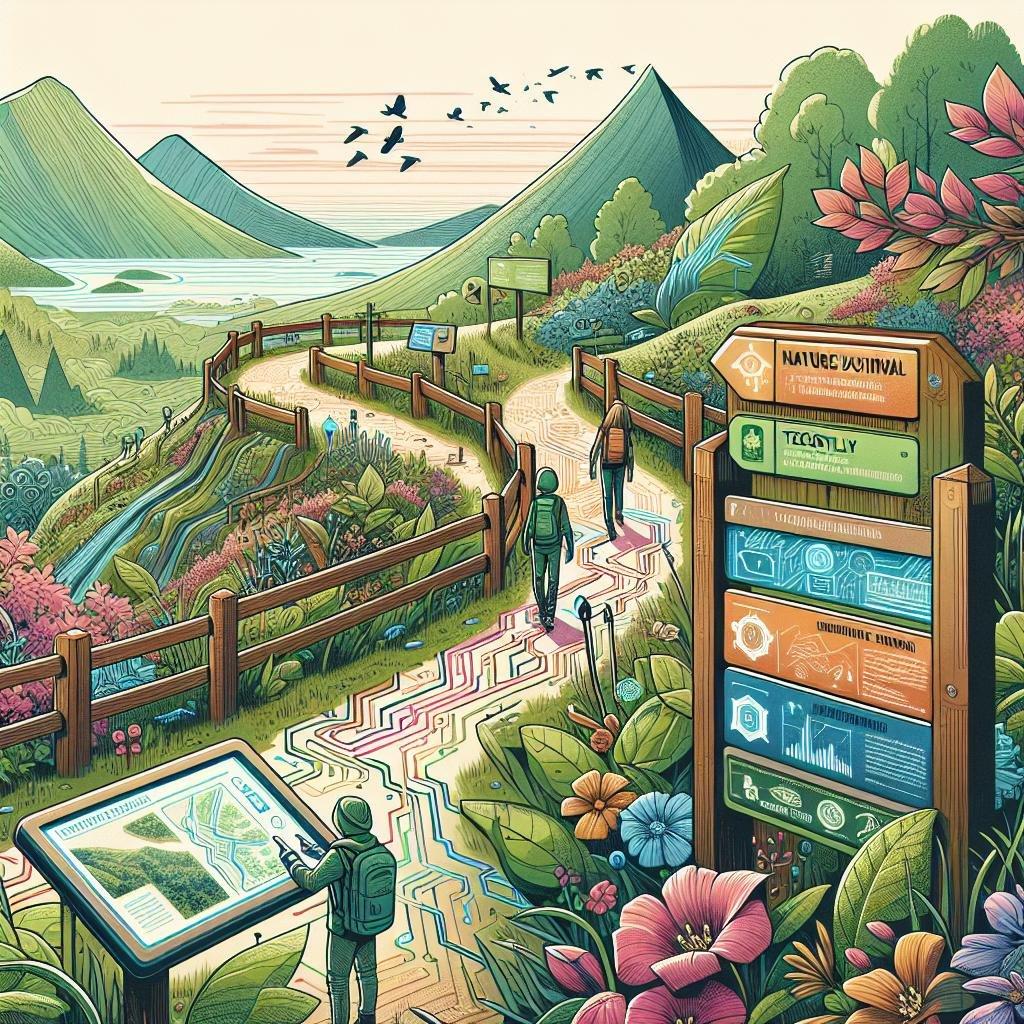Nestled within the verdant embrace of the Great Smoky Mountains, Gatlinburg unravels its trails like a natural tapestry woven with tales of the forest. As each footstep leads the way deeper into this lush wilderness, hikers find themselves embarking on more than just a physical journey; they dive into a narrative spun from nature’s secrets. Here, amidst the whispers of leaves and the murmur of streams, the trails are adorned with interpretive signs that serve as gateways to knowledge, offering insights into the rich tapestry of flora, fauna, and geology. These thoughtful markers transform the pathways into living classrooms, inviting explorers of all ages to pause, reflect, and engage with the captivating stories of the natural world. Gatlinburg’s trails do more than guide—they educate, illuminating the profound symbiosis between land and life in this enchanting corner of the Smokies.
Exploring Natures Classroom: Discover Gatlinburgs Educational Hiking Trails
Gatlinburg’s hiking trails offer more than just stunning vistas; they provide an immersive educational experience with interpretive signs that transform the forest into a living classroom. These trails are dotted with informative markers that give you insights into the vibrant ecosystems, native wildlife, and geological features of the Smoky Mountains. Imagine wandering through lush greenery while learning about the intricate web of life that thrives here, from tiny insects to majestic black bears. Take a moment to appreciate how these paths not only challenge your physical limits but also expand your mind, making each step an opportunity for discovery.
- Nature Trail Interpretive Loop: Features information on local flora and fauna.
- Cove Hardwood Natural Trail: Shares ecological insights on the diverse hardwood forest.
- Quiet Walkways: Offers introspective stops with details on forest conservation efforts.
| Trail Name | Length | Difficulty |
|---|---|---|
| Natures Wonderland | 1.2 miles | Easy |
| Forest Learn Loop | 2.0 miles | Moderate |
Whether you’re a seasoned hiker or a curious explorer, the variety of trails ensures there’s something for everyone. Each trail tells its own story through well-placed signs that introduce you to everything from tree species and bird calls to the cultural history of the Cherokee people who once traversed these lands. Consider bringing a notebook to jot down intriguing facts or questions for further research. As you follow these interpretive pathways, you’ll not only exercise your body but also nurture your curiosity, turning a hike into a holistic educational adventure. Keeping this balance of mindfulness and activity ensures that your journey through Gatlinburg’s landscapes is as enriching as it is enjoyable.

Unearth the Stories of the Smokies: Interpretive Signs that Bring Nature to Life
Meandering through the serene trails in Gatlinburg, hikers are greeted not just by the whispering leaves and the rustling streams, but also by a series of interpretive signs that transform the landscape into an open book of wilderness wonder. These signs are more than just informational boards; they are gateways to the untold stories of the Great Smoky Mountains, designed to bring the past to life, reveal secrets of flora and fauna, and deepen the connection between hikers and the natural world. As you walk the trails, expect to encounter signs that introduce you to the Cherokee folklore, unveil fascinating facts about local wildlife such as the enigmatic salamanders known as “the lungless wonders,” and dive into the ecological significance of ancient trees that have stood the test of time.
- Alum Cave Trail: Offers insights into geological formations and historical tidbits from the mining era.
- Roaring Fork Motor Nature Trail: Drive-through trail with numerous stops to learn about forest ecology and historical buildings.
- Trillium Gap Trail: Highlights key plant species and their medicinal uses by indigenous people.
| Trail Name | Feature | Learning Highlight |
|---|---|---|
| Grotto Falls Trail | Waterfall Views | Species thriving in aquatic environments |
| Cades Cove Loop | Historical Structures | Early settler history and architecture |
| Little River Trail | Wildlife Spotting | Indigenous wildlife and birdwatching tips |
Where Knowledge Meets Adventure: Essential Trails for Nature Enthusiasts
Among the scenic expanses of Gatlinburg’s natural wonderland lies a treasure trove of trails that merge outdoor adventure with the joy of learning. Laurel Falls Trail is perhaps the star attraction, leading hikers on a 2.6-mile roundtrip journey to a breathtaking 80-foot waterfall. Along this route, interpretive signs narrate the forest’s ecology, highlighting the diverse flora such as the native mountain laurel, which gives the trail its name. Equally captivating is the Sugarlands Valley Nature Trail, a shorter, 0.5-mile paved path, where informative boards detail the unique plant and wildlife species. Here, nature enthusiasts can find themselves immersed in stories of the forest’s changing life through the eyes of its long-standing inhabitants. These trails, adorned with nature’s artwork, encourage hikers to pause, observe, and learn about the delicate balance that sustains life in the Great Smoky Mountains.
Naturally crafted for those who seek a deeper connection with nature, the Cataract Falls Trail offers a family-friendly hike complemented by educational waypoints. While covering just under 1 mile, it’s where children and adults alike unlock secrets about the local ecosystems and conservation efforts. For a more adventurous spirit, the Cove Hardwood Nature Trail promises an enlightening journey with signs depicting the dense canopy of old-growth hardwood forests. To aid in the adventure planning, here’s a simple comparison of these trails:
| Trail Name | Length (miles) | Feature |
|---|---|---|
| Laurel Falls Trail | 2.6 | Waterfall |
| Sugarlands Valley Nature Trail | 0.5 | Paved Path |
| Cataract Falls Trail | 1 | Family-Friendly |
| Cove Hardwood Nature Trail | 0.75 | Old-Growth Forest |
Embark on these trails where each signpost becomes a window into the living museum of Gatlinburg’s treasured landscapes.

Tailored Trails for Curious Hikers: Expert Picks and Pathways in Gatlinburg
Embrace the spirit of discovery on the meticulously crafted trails in Gatlinburg, where each step is not just a connection to nature but an educational journey. Hikers will find enchanting pathways adorned with interpretive signs, offering insight into the diverse ecosystems and rich history of the Smoky Mountains. Imagine traversing the Sugarlands Valley Trail, a wheelchair-accessible path renowned for its gentle gradient and bountiful information plaques that illuminate the history of the Cherokee people and the area’s pioneering settlers. Or wander through the Elkmont Nature Trail, where interpretive guides highlight plant and wildlife species native to the region, accompanied by scenic vistas that inspire moments of reflection on nature’s magnificence.
- Sugarlands Valley Trail: Engaging stories of early settlers
- Elkmont Nature Trail: Rich biodiversity and wildlife insights
- Fighting Creek Nature Trail: Highlights unique geological phenomena
For those eager to learn about the park’s geology, the Fighting Creek Nature Trail offers not only tranquil views but also an interactive exploration of rock formations and natural cycles over millennia. Each interpretive sign serves as a storyteller, sharing knowledge that transforms a regular hike into an immersive learning opportunity. To plan your venture, consider the following table highlighting key trail features and facilities:
| Trail | Distance | Wheelchair Accessible | Key Features |
|---|---|---|---|
| Sugarlands Valley Trail | 0.5 miles | Yes | Cultural signs, easy path |
| Elkmont Nature Trail | 1.2 miles | No | Flora & fauna guides |
| Fighting Creek Nature Trail | 1.0 mile | No | Geological insights |
Q&A
Q&A: Exploring Gatlinburg’s Educational Hiking Trails
Q1: What makes Gatlinburg a unique destination for hiking enthusiasts interested in nature education?
A1: Gatlinburg is a gateway to the Great Smoky Mountains, offering a rich tapestry of flora and fauna set against breathtaking landscapes. What sets this area apart for those keen on nature education are the interpretive signs scattered along its hiking trails. These signs provide detailed information about the local ecosystem, history, and geology, transforming a simple hike into an enlightening experience.
Q2: Can you highlight a few trails with interpretive signs that stand out in Gatlinburg?
A2: Certainly! The Sugarlands Valley Nature Trail is a favorite for its accessibility and informative signs that delve into the diverse plant life and cultural history of the area. The Fighting Creek Nature Trail also features interpretive signs that educate hikers on the region’s wildlife and historical landmarks, like the John Ownby Cabin. Lastly, the Cove Hardwood Nature Trail is renowned for its lush forest setting and signs detailing the rich biodiversity of the old-growth forest.
Q3: How do these interpretive signs enhance the hiking experience?
A3: Interpretive signs enrich the hiking experience by offering deeper insights into the environment. They highlight interesting facts about the species of plants and animals, explain ecological relationships, and recount historical anecdotes. This additional layer of information transforms an ordinary trek into a journey of discovery, allowing hikers to connect more meaningfully with their surroundings.
Q4: Are there any specific educational themes covered by these interpretive signs?
A4: Yes, the themes vary but often include ecology, conservation, local history, and cultural insights. For instance, some signs might focus on the importance of biodiversity and habitat preservation, while others might provide historical context about the area’s early settlers or the traditions of the indigenous peoples who once inhabited the region.
Q5: Who can benefit from these educational hiking trails?
A5: These trails are beneficial to a wide audience, including families with children, educators leading field trips, amateur naturalists, and anyone with a curiosity about the natural world. They offer a chance to learn outside of a traditional classroom setting and are accessible for hikers with varying levels of experience due to the diversity in trail difficulty.
Q6: What is the best time of year to visit Gatlinburg for an educational hiking experience?
A6: While each season offers its own unique perspective, many visitors find that spring and autumn are particularly rewarding times. Spring showcases blooming wildflowers and an awakening forest, while autumn offers a spectacular display of foliage, both enhanced by the interpretive signs that explain these natural phenomena. However, summer and winter also have their charm with green canopies and serene snow-covered landscapes, respectively.
Q7: How should hikers prepare for their educational adventure on these trails?
A7: Hikers should come prepared with comfortable walking shoes, water, and a map of the trails. It’s also helpful to bring a notebook or a smartphone to take notes or photos of interesting information. Visitors are encouraged to read the interpretive signs thoroughly and engage with the content to maximize their learning experience.
These educational trails in Gatlinburg not only offer physical exercise but also foster an appreciation and deeper understanding of nature, making them a worthwhile visit for all.
Final Thoughts
As we conclude our exploration of Gatlinburg’s hiking trails adorned with interpretive signs, it’s clear that these paths offer more than just a walk through nature—they promise a journey of discovery. Each sign stands as a testament to the deep connection between the human spirit and the natural world, unraveling the stories of flora and fauna that inhabit this enchanting landscape. Whether you’re a seasoned hiker or a curious wanderer, these trails give each footstep the power to educate and inspire. So, as you lace up your boots and embark on your next adventure, remember that the forest whispers secrets, waiting patiently for you to listen. The mountains of Gatlinburg are calling, inviting you to step into a world where education and nature walk hand in hand.

